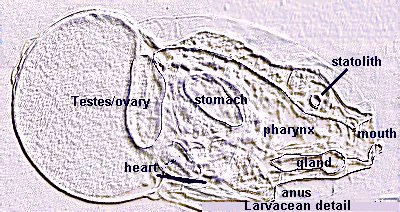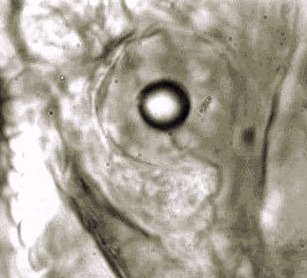|
Tunicates extraordinaire: |
by Jean-Marie Cavanihac, France |
||||
| Another tunicate, much more intriguing, is the LARVACEAN also called APPENDICULARIAN. It looks like a tunicate larva, with notochord also, but it remains at this stage even when it becomes adult. Larvaceans are very abundant in plankton during summer months; their density reaches and often overtakes the copepods. They probably play a great part in the food chain as food for young fishes. |
|
| To catch food, larvaceans have mucus secreting glands near their mouths, forming a filtering area retaining large particles and conducting small phytoplankton or bacteria toward the pharynx. By sinusoidal beating of the tail, (see video clip), the animal creates a vortex which forces water to circulate in the filter area. (Picture shows Oikopleura which is very abundant). I have never seen this structure because its very delicate and destroyed when the animal is caught. (An article on Oikopleura by Wim Van Egmond, discusses and illustrates the difficulties in imaging this structure). |
|
Larvaceans' tail also has a notochord like the ascidian larva. (see left hand picture). Tails are constantly moving and stop only a few seconds. The creature probably has a high metabolism, consuming a lot of oxygen to produce these movements and they don't live for long in a jar (even well aerated and put into a refrigerator to restrict release of dissolved oxygen). Often half the specimens are dead only an hour after collection. |
|
|
| The enlarged image above (a montage of 2
pictures), shows details of a larvacean body (which looks
like an 'Alien'!), but the little round organ above the
mouth, on the right side is NOT an eye and the great
rounded shape on left is NEITHER a brain (fortunately
!...). (See annotated image below). The first of these structures has a spherical shape and appears to be contained within a sort of rounded bag; it's probably an equilibrium organ called the statolith. (See detail below). Statoliths seems to be made with inorganic material like calcium sulphate or magnesium sulphate. I think it does not contain carbonate, because calcium carbonate reacts with hydrochloric acid to produce carbon dioxide bubbles. I have tried to add a little drop of this diluted acid under the coverslip of a slide containing a crushed specimen with statolith, and has been quickly dissolved (like ice cube on warm plate ) without production of bubbles. |
| SCHEMATIC OF LARVACEAN BODY | Detail of statolith (X40 objective) |
 |
 |
|
Larvaceans are not easy to mount because the animal contracts strongly during fixation and becomes very distorted. All pictures in these pages are taken from living specimens. |
||
Comments to the author Jean-Marie Cavanihac are welcomed.
Microscopy UK Front Page
Micscape Magazine
Article Library
All photographs © Jean-Marie Cavanihac 2000
Published in the December 2000 edition of Micscape Magazine.
Please report any Web
problems or offer general comments to the Micscape Editor,
via the contact on current Micscape Index.
Micscape is the on-line
monthly magazine of the Microscopy UK web
site at Microscopy-UK
WIDTH=1